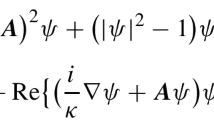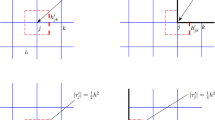Abstract
We introduce finite difference time domain (FDTD) methods for solving the Dirac equation coupled with the Chern–Simons gauge field and provide their error estimates. To discretize the spinor equation, we utilize well-known FDTD schemes, including the Crank–Nicolson method, leap-frog method, and semi-implicit methods. On the other hand, to discretize the gauge equations, we mainly employ the Lorenz gauge condition and derive Crank–Nicolson or leap-frog type finite difference methods for the gauge equations. We establish the error estimates for the introduced FDTD methods and prove the second-order accuracy both in space and time. Numerical examples are also presented to validate the second-order convergence and illustrate the dependencies of the numerical solutions on the parameters or gauge conditions.






Similar content being viewed by others
References
Anderson, C.D.: The positive electron. Phys. Rev. 43, 491–498 (1933)
Alvarez, A.: Linearized Crank–Nicholson scheme for nonlinear Dirac equations. J. Comput. Phys. 99, 348–350 (1992)
Antoine, X., Fillion-Gourdeau, F., Lorin, E., MacLean, S.: Pseudospectral computational methods for the time-dependent Dirac equation in static curved spaces. J. Comput. Phys. 411, 109412 (2020)
Bao, W., Cai, Y., Jia, X., Tang, Q.: Numerical methods and comparison for the Dirac equation in the nonrelativistic limit regime. J. Sci. Comput. 71, 1094–1134 (2017)
Bao, W., Cai, Y., Jia, X., Yin, J.: Error estimates of numerical methods for the nonlinear Dirac equation in the nonrelativistic limit regime. Sci. China Math. 59, 1461–1494 (2016)
Bao, W., Feng, Y., Yi, W.: Long time error analysis of finite difference time domain methods for the nonlinear Klein–Gordon equation with weak nonlinearity. Commun. Comput. Phys. 26, 1307–1334 (2019)
Brinkman, D., Heitzinger, C., Markowich, P.A.: A convergent 2D finite-difference scheme for the Dirac–Poisson system and the simulation of graphene. J. Comput. Phys. 257, 318–332 (2014)
Bao, W., Li, X.: An efficient and stable numerical method for the Maxwell–Dirac system. J. Comput. Phys. 199, 663–687 (2004)
Braun, J.W., Su, Q., Grobe, R.: Numerical approach to solve the time-dependent Dirac equation. Phys. Rev. A 59, 604–612 (1999)
Cho, Y.M., Kim, J.W., Park, D.H.: Fermionic vortex solutions in Chern–Simons electrodynamics. Phys. Rev. D 45, 3802–3806 (1992)
Dunne, G.V.: Self-Dual Chern–Simons Theories. Springer, New York (1995)
Dujardin, G., Faou, E.: Long time behavior of splitting methods applied to the linear Schrödinger equation. C. R. Math. Acad. Sci. Paris 344, 89–92 (2007)
Feng, Y.: Long time error analysis of the fourth-order compact finite difference methods for the nonlinear Klein–Gordon equation with weak nonlinearity. Numer. Methods Partial Differ. Equ. 37, 897–914 (2021)
Fillion-Gourdeau, F., Gagnon, D., Lefebvre, C., Maclean, S.: Time-domain quantum interference in graphene. Phys. Rev. B 94, 125423 (2016)
Fillion-Gourdeau, F., Lorin, E., Bandrauk, A.D.: Numerical solution of the time-dependent Dirac equation in coordinate space without fermion-doubling. Comput. Phys. Comm. 183, 1403–1415 (2012)
Fillion-Gourdeau, F., Lorin, E., Bandrauk, A.D.: Galerkin method for unsplit 3-d Dirac equation using atomically/kinetically balanced B-spline basis. J. Comput. Phys. 307, 122–145 (2016)
Feng, Y., Yin, J.: Spatial resolution of different discretizations over long-time for the Dirac equation with small potentials. J. Comput. Appl. Math. 412, 114342 (2022)
Gosse, L.: A well-balanced and asymptotic-preserving scheme for the one-dimensional linear Dirac equation. BIT Numer. Math. 55, 433–458 (2015)
Huang, Z., Jin, S., Markowich, P.A., Sparber, C., Zheng, C.: A time-splitting spectral scheme for the Maxwell–Dirac system. J. Comput. Phys. 208, 761–789 (2005)
Hong, J., Li, C.: Multi-symplectic Runge–Kutta methods for nonlinear Dirac equations. J. Comput. Phys. 211, 448–472 (2006)
Hammer, R., Pötz, W., Arnold, A.: Single-cone real-space finite difference scheme for the time-dependent Dirac equation. J. Comput. Phys. 265, 50–70 (2014)
Hammer, R., Pötz, W., Arnold, A.: A dispersion and norm preserving finite difference scheme with transparent boundary conditions for the Dirac equation in (1+1)D. J. Comput. Phys. 256, 728–747 (2014)
Horvathy, P.A., Zhang, P.: Vortices in (abelian) Chern–Simons gauge theory. Phys. Rep. 481, 83–142 (2009)
Kim, J., Moon, B.: Finite difference methods for the one-dimensional Chern–Simons gauged models. Discrete Contin. Dyn. Syst. Ser. B 27, 6417–6439 (2022)
Li, J.: Energy-preserving exponential integrator Fourier pseudo-spectral schemes for the nonlinear Dirac equation. Appl. Numer. Math. 172, 1–26 (2022)
Li, S., Bhaduri, R.K.: Planar solitons of the gauged Dirac equation. Phys. Rev. D 43, 3573–3574 (1991)
Lopez, A., Fradkin, E.: Fractional quantum Hall effect and Chern–Simons gauge theories. Phys. Rev. B 44, 5246–5262 (1991)
Li, J., Wang, T.: Optimal point-wise error estimate of two conservative fourth-order compact finite difference schemes for the nonlinear Dirac equation. Appl. Numer. Math. 162, 150–170 (2021)
Li, J., Wang, T.: Analysis of a conservative fourth-order compact finite difference scheme for the Klein–Gordon–Dirac equation. Comput. Appl. Math. 40, Article number 114 (2021)
Li, J., Zhu, L.: A uniformly accurate exponential wave integrator Fourier pseudo-spectral method with structure-preservation for long-time dynamics of the Dirac equation with small potentials. Numer. Algorithms 92, 1367–1401 (2023)
Ma, Y., Yin, J.: Error bounds of the finite difference time domain methods for the Dirac equation in the semiclassical regime. J. Sci. Comput. 81, 1801–1822 (2019)
Neto, A.H.C., Guinea, F., Peres, N.M.R., Novoselov, K.S., Geim, A.K.: The electronic properties of the graphene. Rev. Mod. Phys. 81, 109–162 (2009)
Novoselov, K.S., Geim, A.K., Morozov, S.V., Jiang, D., Katsnelson, M.I., Grigorieva, I.V., Dubonos, S.V., Firsov, A.A.: Two-dimensional gas of massless Dirac fermions in graphene. Nature 438, 197–200 (2005)
Shebalin, J.V.: Numerical solution of the coupled Dirac and Maxwell equations. Phys. Lett. A 226, 1–6 (1997)
Salamin, Y., Hu, S.X., Hatsagortsyan, K.Z., Keitel, C.H.: Relativistic high-power laser-matter interactions. Phys. Rep. 427, 41–155 (2006)
Shao, S.H., Tang, H.Z.: Higher-order accurate Runge–Kutta discontinuous Galerkin methods for a nonlinear Dirac model. Discrete Contin. Dyn. Syst. Ser. B 6, 623–640 (2006)
Wang, R., Wang, B., Sedrakyan, T.: Chern–Simons superconductors and their instabilities. Phys. Rev. B 105, 054404 (2022)
Wang, H., Tang, H.: An efficient adaptive mesh redistribution method for a nonlinear Dirac equation. J. Comput. Phys. 222, 176–193 (2007)
Xu, J., Shao, S., Tang, H.: Numerical methods for nonlinear Dirac equation. J. Comput. Phys. 245, 131–149 (2013)
Acknowledgements
J. Kim is grateful for support by the Open KIAS Center at Korea Institute for Advanced Study.
Funding
The work of B. Moon is supported by Basic Science Research Program through the National Research Foundation of Korea funded by the Ministry of Education (NRF-2022R1I1A1A01059922).
Author information
Authors and Affiliations
Corresponding author
Ethics declarations
Conflict of interest
The authors declare no competing interests.
Additional information
Publisher's Note
Springer Nature remains neutral with regard to jurisdictional claims in published maps and institutional affiliations.
Appendix A. Proof of the Conservation of the Energy
Appendix A. Proof of the Conservation of the Energy
In this appendix, we provide a proof for the conservation of the energy E(t) of the CSD equation. Recall that the energy E(t) is given by
To show that \(\frac{d }{d t}E(t)=0\), we first multiply (1.2)\(_1\) by \((\partial _t\psi -i A_0\psi )^\dagger \) and take the real part to obtain
Then, integrating over the domain \(\Omega \) yields the following:
where we used the gauge equation in the last equality. Therefore, the energy E(t) for the CSD equation is conserved, regardless of the gauge condition.
Rights and permissions
Springer Nature or its licensor (e.g. a society or other partner) holds exclusive rights to this article under a publishing agreement with the author(s) or other rightsholder(s); author self-archiving of the accepted manuscript version of this article is solely governed by the terms of such publishing agreement and applicable law.
About this article
Cite this article
Kim, J., Moon, B. Finite Difference Time Domain Methods for the Dirac Equation Coupled with the Chern–Simons Gauge Field. J Sci Comput 99, 9 (2024). https://doi.org/10.1007/s10915-024-02473-w
Received:
Revised:
Accepted:
Published:
DOI: https://doi.org/10.1007/s10915-024-02473-w




